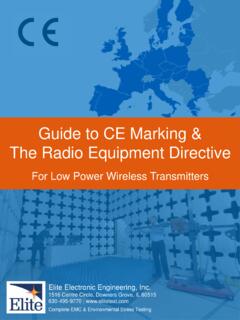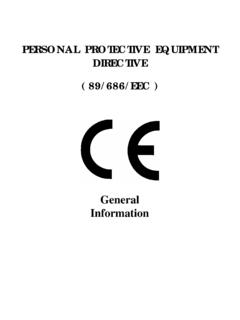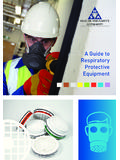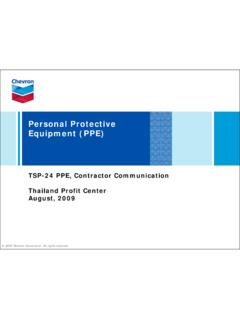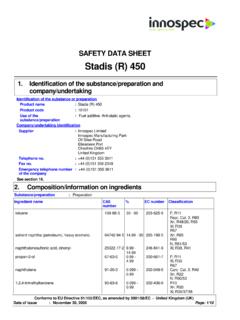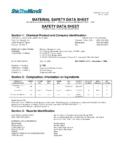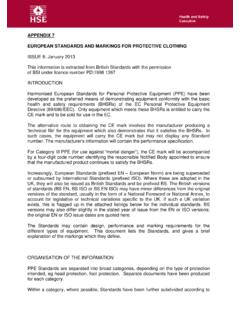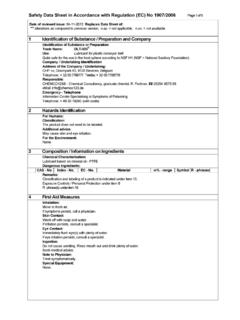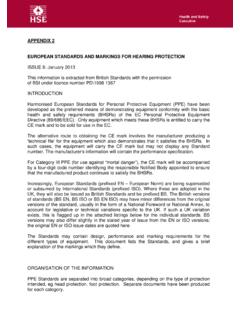Transcription of Guide to CE Marking & Radio Equipment Directive
1 Guide toCE Marking & Radio Equipment Directive for Low PowerWireless TransmittersProvided byElite Electronic Engineering, Centre Circle, Downers Grove, IL 60515630-495-9770 | EMC & Environmental Stress TestingJune 17, 2016 Table of Contents1CE and RED OverviewPage 3 What does it cover and where does it apply2 Determine the RequirementsPage 8 Directives and Harmonized Standards3 Testing for the Effective Use of Spectrum Page 16 Power, spurious emissions, and spectrum sharing4 Testing for EMCPage 19 Evaluate the integrated transmitter system for EMC5 Tests/Analysis for Low Voltage Directive Page 20 The LVD applies with no voltage limit. 6 Gather Documentation Page 22 Your objective evidence of compliance7 Transitioning to REDPage 28 What s necessary to move from R&TTE to RED?28 Final CommentsPage 26 What s the next step with Elite to get my testing completed ?The CE Mark is the label placed on manufactured and imported goods in the European Union.
2 It declares that a product meets the applicable essential health and safety requirements for European citizens. This one label and the regulatory infrastructure behind it comprise the product conformity laws for the 28 European Union nations along with the EFTA countries of Iceland, Liechtenstein, and Norway. The CE processes are also adopted by Switzerland and Turkey through separate trade agreements. The CE Mark replaces a patchwork of individual regulatory schemes where previously every one of the separate European countries operated with their own rules, regulations, process, and conformity marks. Many non European nations also accept CE mark techincal compliance file as evidence of conformity with their regulations without the need for furter tests and evaluation. And though some nations will only accept in country testing, they still follow standards aligned with the procedures and technical requirements specified in the European CE Marking regulations.
3 The CE regulations cover a broad range of products and set the requirements for the essential health and safety of Union citizens as well as for product operability. There are over 20 different new approach directives. Some are product and industry specific directives for cagetories such as medical electronics and Radio transmitters and others are more general directives such as Low Voltage or EMC. The CE mark is indeed a wide ranging European requirement, but its acceptance and adoption by other nations plus the broad range of products that it applies to makes its reach truly global. 1CE and RE Directive Overview3 What is the CE Mark and where does it apply ? European Union (EU)The focus of this document is to describe the CE Marking conformity assessment process for low power short range wireless devices. This information will address the more common transmitters and receivers such as Bluetooth, WiFi, Zigbee, and other low power devices.
4 These transmitters have operating frequencies harmonized for use throughout the EU. Starting in June 2016 the Radio Equipment Directive (RED) is the new compliance requirement in Europe for wireless transmitters. The RED replaces the R&TTE Directive which previously covered Radio transceivers and telephone Equipment . There is a one year transition period for manufacturers who have previously issued conformity assessments for the R&TTE to transition to the RED. Many other of the European New Approach Directives have also been updated recently including the EMC and Low Voltage Directives. The new EMC and LVD came into law in April 2016 but without any transition period. 1 CE & RE Directive Overview4 What is the RE Directive ? Directives Updates April 2016 Low Voltage 2014/35/EU EMC 2014/30/EUATEX 2014/34/EULifts 2014/33/EUSimple Pressure Vessels 2014/29/EUMeasuring Instruments 2014/32/EUCivil Explosives 2014/28/EU Non automatic Weighing Instruments 2014/31/EUDirectives Updates April 2016 Low Voltage 2014/35/EU EMC 2014/30/EUATEX 2014/34/EULifts 2014/33/EUSimple Pressure Vessels 2014/29/EUMeasuring Instruments 2014/32/EUCivil Explosives 2014/28/EU Non automatic Weighing Instruments 2014/31/EUPreviously Updated DirectivesPyrotechnic Articles 2013/29/EU Toy Safety 2009/48/EU RoHS 2011/65/EU Recreational Craft 2013/53/EU Previously Updated DirectivesPyrotechnic Articles 2013/29/EU Toy Safety 2009/48/EU RoHS 2011/65/EU Recreational Craft 2013/53/EU Future Updates Pressure Equipment 2014/68/EUMarine Equipment 2014/90/EU Future Updates Pressure Equipment 2014/68/EUMarine Equipment 2014/90/EU R&TTE Directive Transition June 12.
5 2016 Either R&TTE or RED June 13, 2017 Only RED 1 CE & RE Directive OverviewThe recent changes to the European CE directives are driven by initiatives for alignment with the EU s New Legislative Framework (NLF). The New Legislative Framework is a set of EU regulations that provide enhanced definitions and specific descriptions on the European conformity processes. They provide more detail for the meaning of the CE Mark so that the responsibilities of all economic operators are clear. The regulations bring better clarity and process for policies on accreditation and for recognition of notified bodies and other conformity assessment parties. In addition, the NLF establishes a more structured process for enhancing import controls and for addressing market surveillance. The objectives of the NLF is to lessen the burden on manufacturers and importers and improve trade while maintaining the safety of users. For a few manufacturers the technical changes resulting from the alignment of directives with the NLF will be significant.
6 However, for most manufacturers within the scope of the R&TTE or new RED the impact of the changes will be minimal. For now, manufacturers will simply update technical files and Declarations of Conformity to remain complaint with the RE Directive . 5 What s the reason behind the update in Directives? New Legislative Framework (NLF) Regulation (EC) No 764/2008 Regulation (EC) No 765/2008 Regulation (EC) No 768/2008 Main objectives of NLF Regulations Restate and detail definitions , ie Manufacturers Importers Distributors Representatives Structure policies for accreditation Refine processes for notification of CABs Address market surveillance Enhance import controls Clarify meaning of CE MarkNew Legislative Framework (NLF) Regulation (EC) No 764/2008 Regulation (EC) No 765/2008 Regulation (EC) No 768/2008 Main objectives of NLF Regulations Restate and detail definitions , ie Manufacturers Importers Distributors Representatives Structure policies for accreditation Refine processes for notification of CABs Address market surveillance Enhance import controls Clarify meaning of CE MarkThe Radio Equipment Directive , or RED is a product specific Directive that establishes the requirements for all wireless transmitters and receivers (*see exclusions).
7 The scope of the RED includes Radio devices that range from cell phone handsets and cell base stations to 2 way land mobile radios and their base stations. It covers microwave backhaul transmission systems, certain marine applications, emergency beacons, radar, Radio astronomy, and many others. One of the common characteristics for these aforementioned devices is their transmit power levels are typically at or above 1W (low power devices are described next) and many are licensed service applications, meaning that in addition to the device conformity assessment the end user may need to receive a license to transmit at the particular frequency band. VHF and UHF business and professional radios are examples of licensed device applications. Licensed devices receive exclusive rights to transmit on a particular frequency, at a specified power, and for a defined geographic location. However, unlicensed transmitters are permitted to transmit on certain licensed bands but at power levels that will not interfere with licensed users.
8 1 CE & RE Directive Overview6 What types of products are covered by RE Directive ? * Equipment Excluded from RED Police, military & state security Radio amateurs Marine SOLAS Equipment Cables and wiring Civil aviation & air traffic control* Equipment Excluded from RED Police, military & state security Radio amateurs Marine SOLAS Equipment Cables and wiring Civil aviation & air traffic controlLicense exempt transmitters include many familiar consumer products like WiFi, Bluetooth, Zibgee, remote keyless entry, RFID, and garage door controls. These devices typically transmit at less than 200mW and operate in designated frequency bands with specified powers, bandwidths, and duty cycles. They are primarily sold without the user having to obtain a license. The applications of low power wireless transmitters are growing rapidly and feeding the pace of expansion for the Internet of Things. Manufactures of wireless devices that are sold into Europe must comply with all the regulations associated with the CE Mark plus any other non CE requirements.
9 The European Union requirements for short range wireless transmitters are particularly unique in that the responsibility for declaring compliance is the manufacturer or importer of the device. There is typically not a third party type approval for wireless devices like that in the United States or as in nearly every other country around the world. Once the product is determined to be RED compliant by the manufacturer, importer, or distributor it can be placed on the market and sold to any buyer. 1 CE & RE Directive Overview7 What types of low power transmitters ? 2 Determine CE RequirementsThe RED conformity assessment process is illustrated in the figure at the right. Step 1 begins by determining the applicable directives, technical standards, and conformity assessment procedures. Step 2 covers the tests and engineering assessments of the design, construction, and safety operations. In Step 3, the reports and findings from the evaluations are prepared, collected, and maintained to substantiate the compliance.
10 Finally in Step 4 the product is labeled and a Declaration of Conformity (DoC) is prepared to notify the end user and regulatory agencies that the product is ready for placement in the market. In Step 5, manufacturers are required to maintain compliance throughout the life of the product. This includes evaluating continuing compliance despite component replacements, product improvements, and redesigns. This seemingly straightforward process has proven effective for over 15 years with the R&TTE Directive and now the RED. It has helped sustain the expansive growth of wireless communications in Europe with relatively few instances of interference. 8 What is the process for RE Directive CE Marking ? Step 1 Determine All Applicable RequirementsDirectivesFrequency BandsConformity Assessment ModuleHarmonized StandardsStep 2 Perform Testing and AnalysisEffective Use of SpectrumEMCLow Voltage Directive Step 3 Prepare Technical File Step 4 Label Device and Issue the DoCStep 5 Maintain Technical File and Continuing ComplianceNew Approach CE Marking DirectivesGeneral DirectivesProduct or Application Specific DirectivesProduct or Application Specific DirectivesChemical substances (REACH)Ecodesign hot water boilersEcodesign and energy labellingEcodesign and energy labellingEco management and audit scheme (EMAS)Electromagnetic compatibility (EMC) Equipment for explosive atmospheres (ATEX)Low Voltage (LVD)Machinery (MD)New legislative framework (NLF)Packaging and packaging wasteRestriction of hazardous substances (RoHS)Explosives for civil usesGas appliances (GAD)Inspection pesticide application equipmentLiftsMeasuring instruments (MID)
